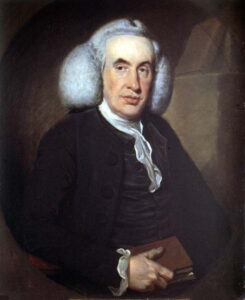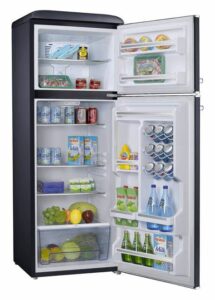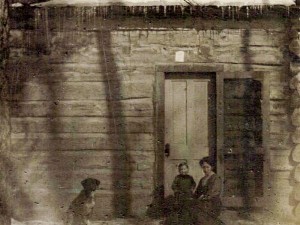refrigerator
 When Roy Plunkett went to work that day, his plan was to make a better refrigerator. Plunkett was a chemist who worked for a company named DuPont. It was a dream job for a 27-year-old man, just starting his working career. A plan had been forming in his brain as to how the refrigerator could be improved. The chemicals necessary were a gas named Tetrafluoroethylene and Hydrochloric Acid. He has gathered the chemicals together, but he wasn’t quite ready to start experimenting yet, so he cooled and pressurized the Tetrafluoroethylene gas in canisters overnight, planning to get started bright and early the next morning.
When Roy Plunkett went to work that day, his plan was to make a better refrigerator. Plunkett was a chemist who worked for a company named DuPont. It was a dream job for a 27-year-old man, just starting his working career. A plan had been forming in his brain as to how the refrigerator could be improved. The chemicals necessary were a gas named Tetrafluoroethylene and Hydrochloric Acid. He has gathered the chemicals together, but he wasn’t quite ready to start experimenting yet, so he cooled and pressurized the Tetrafluoroethylene gas in canisters overnight, planning to get started bright and early the next morning.
When Plunkett returned the next day, he found that there was no gas in the canisters. Oddly, the canisters weighed the same amount as when they were full, but nothing came out of them. Well, this was confusing!! Where did all the gas go? Now, Plunkett was intrigued, so he cut the canisters in half. During the cooling process, the gas had solidified on the sides of the canisters, creating a slick surface. I can only imagine what their thoughts were on that. They had to figure out what had happened. The use of the chemical was one thing, but curiosity about what had happened was more than Plunkett to stand to just let go.
According to the account in DuPont’s history annals, “Rather than discard the apparent mistake, Plunkett and his assistant tested the new polymer and found that it had some very unusual properties: it was extremely slippery as well as inert to virtually all chemicals, including highly corrosive acids. The product, trademarked as Teflon in 1945, was first used by the military in artillery shell fuses and in the production of nuclear material for the Manhattan Project.” Of course, these days, we all know about Teflon. The main use is in non-stick cookware. It has other uses, but that is the one we all would know, because Teflon became a household word. Any cook, chef, homemaker, or even bachelor, knows about Teflon cookware. It’s big part of cooking life.
 While cookware is the main thing that Teflon is used for, Plunkett wasn’t thinking of cookware when he invented it. In fact, it wasn’t until a decade after Plunkett sawed those canisters in half, that a French engineer named Marc Grégoire saw the cookware value and introduced “Tefal” pans…the first to be lined in Teflon. The funny thing is that the idea actually came from his wife. I suppose that the person who normally did the cooking in those days, would be the one to see the value in a non-stick finish. Before Tefal, Grégoire used Teflon on his fishing tackle to prevent tangling. The guys thought of fairly good uses, but Grégoire’s wife realized that the nonstick surface would be perfect for cookware.
While cookware is the main thing that Teflon is used for, Plunkett wasn’t thinking of cookware when he invented it. In fact, it wasn’t until a decade after Plunkett sawed those canisters in half, that a French engineer named Marc Grégoire saw the cookware value and introduced “Tefal” pans…the first to be lined in Teflon. The funny thing is that the idea actually came from his wife. I suppose that the person who normally did the cooking in those days, would be the one to see the value in a non-stick finish. Before Tefal, Grégoire used Teflon on his fishing tackle to prevent tangling. The guys thought of fairly good uses, but Grégoire’s wife realized that the nonstick surface would be perfect for cookware.
 Most people, these days, don’t necessarily know who William Cullen is, but historically speaking, he is a very important man. Born April 15, 1710, in Hamilton, Lanarkshire, the son of William Cullen…a lawyer and Elizabeth Roberton of Whistlebury. Cullen was a Scottish physician, chemist and agriculturalist, as well as a professor at the Edinburgh Medical School, but these things would not be the defining accomplishment of his life. Cullen saw a need for something, that many people knew they needed, but no one knew how to get it.
Most people, these days, don’t necessarily know who William Cullen is, but historically speaking, he is a very important man. Born April 15, 1710, in Hamilton, Lanarkshire, the son of William Cullen…a lawyer and Elizabeth Roberton of Whistlebury. Cullen was a Scottish physician, chemist and agriculturalist, as well as a professor at the Edinburgh Medical School, but these things would not be the defining accomplishment of his life. Cullen saw a need for something, that many people knew they needed, but no one knew how to get it.
Years ago, towns had an icehouse. Snow and ice were stored in a cellar in an effort to keep them frozen for use by the townspeople. Then the icehouse owner would bring ice to people, and it would basically be kept in a “cooler” so food could be kept cold for a while. It was an imperfect system, but it was all they had. Cullen could see that something better was needed. I’m sure he saw the diseases that came from spoiled food and maybe even deaths from that food. That got him thinking.
After Cullen completed his education at the University of Glasgow and the University of Edinburgh, he started his formal career. His field of study and subsequent career in medicine and after completing the studies, he started in that career, but he was also interested in working on a scientific basis to invent different things. That was when Cullen envisioned and then invented an artificial refrigerator which was used manually to save many things from getting wasted.
These days, the refrigerator is an appliance which can be found in almost every house, and it is one of the most used appliances. It comes in different shapes and in different sizes. Normally, it is made up in “the form of two compartments and one of them is insulated thermally, while the other compartment consists of a heat pump and its important function is the transfer of heat. This transfer is done to manage heat environment.” I don’t presume to understand how all that works. I just know that my food stays the temperature it needs to be to either freeze it of just keep it cold.
In 1741 he married Anne (or Anna) Johnstone, who died 1786. He was father to Robert Cullen and Henry Cullen, who became a physician. Cullen’s eldest son Robert became a Scottish judge in 1796 under the title of Lord Cullen, and later Baron Cullen, and was known for his powers of mimicry. Cullen died in Edinburgh, Scotland on February 5, 1790. He was almost 80 years of age at the time of his death.
 Years ago, long before refrigeration was safe to use, most people had a more primitive way to keep foods fresh or frozen. I say that this was before refrigeration was safe to use, because mechanical refrigeration was actually invented in 1748 by William Cullen and was demonstrated at the University of Glasgow. This version was not used for any practical purpose, however. In 1805, an American inventor named Oliver Evans designed the first refrigeration machine, and the first person to make a practical refrigerating machine was Jacob Perkins in 1834, using Ether in a vapor compression cycle. American physician, John Gorrie, built a refrigerator based on Oliver Evans’ design in 1844 which he used to make ice to cool the air for his yellow fever patients. German engineer Carl von Linden, patented not a refrigerator but the process of liquefying gas in 1876 that is part of basic refrigeration technology. Refrigerators in the late 1800s and up until 1929 used toxic gasses, such as ammonia, methyl chloride, and sulfur dioxide as refrigerants, which were responsible for several fatal accidents in the 1920s. I suppose the cost and the dangers of these early models were the main reasons that people continued to used the old fashioned version.
Years ago, long before refrigeration was safe to use, most people had a more primitive way to keep foods fresh or frozen. I say that this was before refrigeration was safe to use, because mechanical refrigeration was actually invented in 1748 by William Cullen and was demonstrated at the University of Glasgow. This version was not used for any practical purpose, however. In 1805, an American inventor named Oliver Evans designed the first refrigeration machine, and the first person to make a practical refrigerating machine was Jacob Perkins in 1834, using Ether in a vapor compression cycle. American physician, John Gorrie, built a refrigerator based on Oliver Evans’ design in 1844 which he used to make ice to cool the air for his yellow fever patients. German engineer Carl von Linden, patented not a refrigerator but the process of liquefying gas in 1876 that is part of basic refrigeration technology. Refrigerators in the late 1800s and up until 1929 used toxic gasses, such as ammonia, methyl chloride, and sulfur dioxide as refrigerants, which were responsible for several fatal accidents in the 1920s. I suppose the cost and the dangers of these early models were the main reasons that people continued to used the old fashioned version.
The old fashioned way to keep foods fresh or frozen, involved using ice and snow, which they would bring in from the mountains, or use what was on the ground, if it was available. They would dig a cellar in the ground,  and line it with wood or straw. Then they packed it with snow and ice, and the food was placed in the cellar. It was this type of refrigeration system that my grandparents, Allen and Anna Spencer, were using at the time my Aunt Laura Fredrick was a very little girl in about 1913. My grandparents were living in a wooded area in northern Minnesota near American Falls. Grandpa was working in the lumber business at that time.
and line it with wood or straw. Then they packed it with snow and ice, and the food was placed in the cellar. It was this type of refrigeration system that my grandparents, Allen and Anna Spencer, were using at the time my Aunt Laura Fredrick was a very little girl in about 1913. My grandparents were living in a wooded area in northern Minnesota near American Falls. Grandpa was working in the lumber business at that time.
According to my Uncle Bill Spencer, who was their second child, the cellar was probably not needed much in the long winter months, because the house stayed pretty cold up there anyway. I’m sure that they had wood for a fire, but then again, I suppose that everything they burned, was something that could not bring in money. Also, they lived in a log cabin, that was apparently not very well built, or at least the spaces in between the logs were not really well packed with mud to keep the cold winter air on the outside of the house, where it belonged.
I’m not sure how far the cellar was from the house, because, I can’t see the house in the picture, so it might have been a little way from the house, or the picture might have been taken from the house. Either way, getting food from the cellar was a bit of a process, because you don’t want to upset the cooling process by removing the straw too often, as it was part of what kept the ice and snow from melting.
 I can’t say when my grandparents got their first real refrigerator, but I expect that like many people of that time, they were a little bit leery of the early refrigerators, after hearing about people dying because the gasses leaked out of the unit. I suppose it was the price people paid to be able to use some of the early inventions, but many people felt that the price was too high, so they waited until these new fangled gadgets were proven safe before they took a chance on them. And, I’m sure that like any new thing, they were pretty expensive early on too. The cellar would work just fine for now, and therefore, that is what my grandparents were using at that time in our family history. These days, we would be shocked at such a method of keeping food fresh.
I can’t say when my grandparents got their first real refrigerator, but I expect that like many people of that time, they were a little bit leery of the early refrigerators, after hearing about people dying because the gasses leaked out of the unit. I suppose it was the price people paid to be able to use some of the early inventions, but many people felt that the price was too high, so they waited until these new fangled gadgets were proven safe before they took a chance on them. And, I’m sure that like any new thing, they were pretty expensive early on too. The cellar would work just fine for now, and therefore, that is what my grandparents were using at that time in our family history. These days, we would be shocked at such a method of keeping food fresh.

